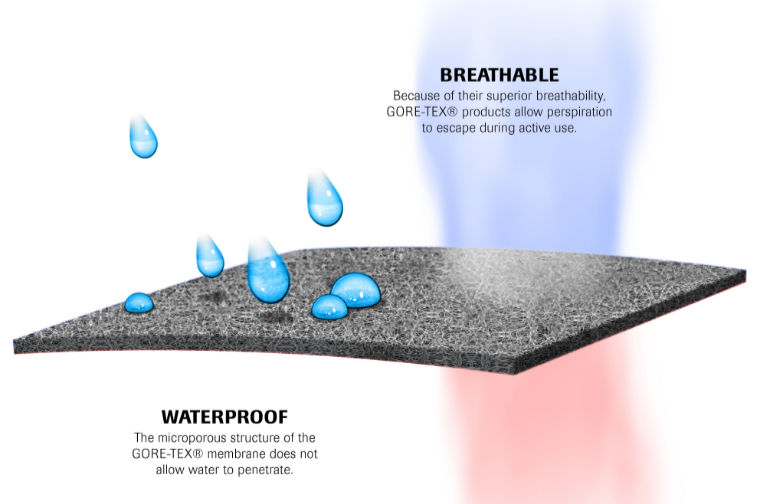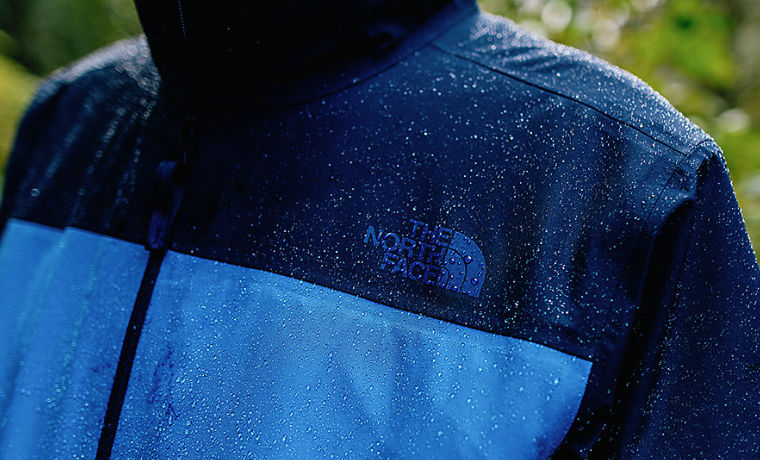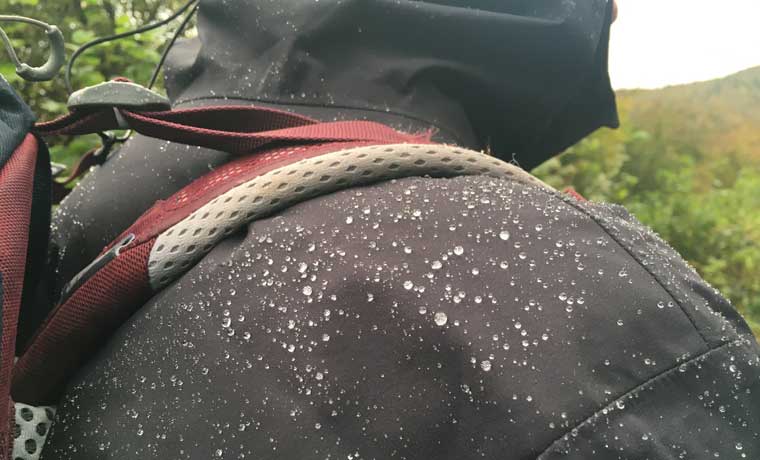It’s 8am and raining here in normally sunny Cyprus. This means it’s time to break out my rainwear and think about which walking shoes I’m going to wear. Cocooned in my high-tech wet weather gear, I’ll be able to stay pretty dry and warm in even a torrential downpour.
This has not always been the case…
Growing up, I had one raincoat – a yellow rubberised nylon monstrosity that kept water out but trapped sweat in. Needless to say, after wearing this garment for an hour or so, I was wet anyway, as the moisture had no way to escape and condensed inside the coat.
And, if I wanted to keep my feet dry, I had to rely on waxed leather boots or rubber wellies.
My, how things have changed!
Modern adventurers have access to a vast array of garments and materials to protect them from the elements. However, faced with so many choices, it’s not always easy to know what to buy.
For example, what’s the difference between waterproof and water resistant? Which is best, and what do you need?
In this article, we explore the difference between waterproof vs. water-resistant so you can choose the best option for your adventure needs.
- Water-resistant vs. waterproof – the basics
- Waterproof ratings
- Common waterproof fabrics and materials
- Waterproof fabrics: membrane vs non-membrane
- Waterproof vs. water-resistant – FAQs

Water-resistant vs. waterproof – the basics
While it’s easy to confuse water resistant with waterproof (and don’t forget water repellent, too!), they are very different things.
Water-resistant fabrics
Water-resistant fabrics and materials can repel modest amounts of moisture, such as light rainfall or mist. They are usually lightweight, windproof, and often very breathable, so you won’t sweat too much.
This makes water-resistant clothing ideal for fair-weather athletes and fast-moving outdoor enthusiasts who value a small pack size and low weight more than staying completely dry.
Water-resistant clothing is ideal for keeping in your pack so you can break it out if needed. Or you can wear it just in case it rains but accept that if the weather gets really bad, you’ll probably get wet anyway.
Waterproof fabrics
Waterproof fabrics are virtually impervious to water. I say virtually because the actual degree of waterproofness will depend on the rating and construction of the garment. For example, seams and zips can leak, and some materials are more waterproof than others.
However, a waterproof fabric should keep water out for quite a long time, and water should “bead” or gather on the surface of the material rather than soak into it.
Waterproof fabrics are often breathable but are usually a little less so than water-resistant garments and tend to be heavier and bulkier.
Water-repellent fabrics
Water-repellent fabrics work as well as some so-called waterproof materials. They usually cause water to bead on the surface. However, most water-repellent fabrics rely on a coating applied to the outside of the garment rather than the material itself. They also tend not to be very breathable.
You can buy sprays and wash-in treatments to restore water repellence or even weather-proof a non-water repellent item, e.g., a pair of standard running shoes. I once treated a pair of regular walking trousers to make them water-repellent and it worked like a charm. However, the effect was only temporary.
Waterproof ratings
Waterproofing is rated in one of two ways – hydrostatic head and ingress protection. However, hydrostatic head is most commonly used for clothing, while ingress protection is used for equipment and devices.
Hydrostatic head scale
Hydrostatic head (HH) is a measurement used to calculate how waterproof a garment or fabric is. The HH score, displayed in millimetres, refers to the height of a column of water. The higher the column, the more pressure on the material, and the better the material is as keeping water out.
For something to be considered waterproof, it should have a HH rating of 1000 or more. For example, a good waterproof coat could have a HH of 20,000 and a premium backpacking tent 5,000.
However, to be fully waterproof, things like zips and seams must also be considered, and even a jacket with an HH of 30,000 will leak if the seams are not taped correctly. It’s also worth noting that a high HH may mean that the material is less breathable, and condensation can become a problem.
Ingress protection waterproof scale
The ingress protection or IP waterproof scale measures how well a device or object can withstand water. It’s used on things like handheld GPS devices, earphones, adventure watches, waterproof cameras, mobile phones, etc.
Like the HH scale, the higher the IP score, the better your device or equipment is protected.
- IPX0: No special protection from water.
- IPX1: Can resist water that drips vertically.
- IPX2: Can resist water that hits the product at a 15° angle or less.
- IPX3: Can take water sprays of up to 60°.
- IPX4: Is resistant to water splashes from any direction.
- IPX5: Can resist a sustained, low-pressure water jet spray.
- IPX6: Can resist high-pressure, heavy sprays of water.
- IPX6K: Can resist water jets of extremely high pressure.
- IPX7: Can be submerged up to 1 meter in water for 30 minutes.
- IPX8: Can be submerged deeper than one meter.
- IPX9K: Resists high-pressure, high-temperature sprays at close range.
Not having an IP rating does not mean your device isn’t waterproof, as some manufacturers may just describe in words how waterproof their products are, e.g., up to one meter of water for five minutes.

Image credit: Gore-Tex
Common waterproof fabrics and materials
Manufacturers use a range of fabrics and materials to keep you dry, and the best waterproof fabrics work in much the same way – they’re semi-permeable.
In simple terms, this means the fabric’s weave is so small that water molecules cannot pass through them. However, water vapour molecules are much smaller, so sweat can escape with less condensation on the inside of the material.
Depending on the product and manufacturer, these waterproof fabrics can be used alone or bonded to other materials in single or multiple layers. More layers mean a higher degree of waterproofing.
Not all waterproof materials are breathable, and while they do an excellent job of keeping water out, they also trap moisture in, which can lead to sweating.
Some of the most common waterproof fabrics include:
Gore-Tex
The original Gore-Tex was invented in 1969. Initially, it was very expensive and hard to get hold of, but it is now the standard material used to make outdoor clothing and footwear waterproof. If you see GTX on your jacket or shoes, that usually denotes the use of Gore-Tex in the construction.
The great thing about Gore-Tex is its breathability. As well as keeping water out, it lets sweat evaporate away from your skin.
The degree of waterproofness depends on the number of layers of Gore-Tex used, and there are single, double, and triple-layered garments available. However, more layers mean more weight and bulk and less breathability.
There are also several types of Gore-Tex material, including:
Gore-Tex Shake Dry
- Gore-Tex Paclite
- Gore-Tex Paclite Plus
- Gore-Tex Active
- Gore-Tex Performance
- Gore-Tex Pro
Gore-Tex materials tend not to be rated using the HH scale. Instead, the manufacturer will detail how waterproof their products are.
Pertex
After Gore-Tex came Pertex. Pertex is usually a little cheaper than Gore-Tex and often lighter, too. However, it may not be as breathable. The two most common Pertex variations are Pertex Shield and Pertex Shield Pro.
Dermizax
Dermizax is a waterproof laminate from Japan. It’s fully recyclable and breathable and available in two and three layers. Dermizax is highly waterproof and commonly used in mountain wear.
Polartec Neo Shell
Polartec Neo Shell is a nano-spun material that is micro-porous, so it won’t let water in but can let water vapour out. It’s widely used by many outdoor clothing companies, including Berghaus, Mountain Hardware, and 66North.
Futurelight
Made by outdoor company The North Face, Futurelight is one of the newest waterproof materials on the market and was only launched in 2019. It’s made from 60% recycled material and is 100% reusable. It’s highly waterproof, light, flexible, and breathable, so it’s ideal for active outdoor adventurists.
Sympatex
Sympatex garments are available in two, three, or four layers. It’s made from 100% polyester, so it’s fully recyclable. Vaude is one of the most notable users of Sympatex. It’s often used to make ski and mountain wear.
Proflex
Made and used by outdoor company RAB, this waterproof yet breathable material is soft and flexible and gives a softshell feel to hardshell clothing.
Waxed fabric/leather
Jackets and boots treated with wax are very waterproof but not breathable. They also need to be retreated to stay waterproof, often after just a few uses. However, waxed fabrics and leather can be a good choice for casual use, and as they age, they tend to take on a pleasing weathered look. Think traditional leather hiking boots (sans Gore-Tex liner) and waxed cotton hunting jackets.
Other waterproof but non-breathable materials include:
PVC-coated nylon, polyester, etc.
- Rubberised nylon
- Laminated cotton
- Oil cloth
- Polyester fleece
- Vinyl
- PEVA
- Coated leather

Waterproof fabrics: membrane vs non-membrane
Unlike Gore-Tex, which bases its concept on a waterproof breathable membrane that is laminated to fabric, some waterproof garments adopt a membrane-free waterproofing method. Páramo clothing is an example of this. Their waterproofs last longer than conventional waterproofs, offering renewable waterproofing and repairability. Páramo waterproofs also use fabrics designed NOT to become obsolete. The unique Nikwax Analogy fabric system provides fantastic ultra-breathable and Directional performance, keeping the weather out without recourse to laminates, membranes or taped seams. As a result, there is no element to break down or fail over time. Instead, the waterproofing is renewable indefinitely with water-based Nikwax aftercare products.
The PFC-Free Nikwax Analogy Waterproof System used by Páramo was the first of its kind when it was launched and introduced a whole new concept of waterproof clothing to the international stage. The system mimics the way that furry mammals keep warm and dry, but without the weight and bulk of a mammal fleece. Nikwax Analogy is directional, which means that it forces moisture away from the wearer, pushing out condensation (liquid water) as well as moisture vapour. It manages condensation much better than membrane systems, and has already been shown to be the waterproof system of choice for Mountain Rescue teams, Arctic explorers and outdoor enthusiasts.
The non-membrane waterproof garments, such as those produced by Páramo, are constructed using a 2-layer approach. This approach consists of a pump liner that mimics the action of animal fur – pushing liquid water outwards to protect you from rain, condensation and perspiration, while protecting your insulation. This is combined with a Directional outer that’s treated with PFC-Free DWR to deflect wind and rain. The pump liner isn’t bonded to the face fabric, creating an air gap between the two materials and provides insulation whilst maintaining breathability. This liner is not only designed to allow moisture vapour to pass through, as with Gore-Tex, but also to actively transport liquid water – like sweat – away from the body.
Additionally, non-membrane waterproof garments are easily repairable and are not compromised by puncture (you could stick pins all over a Páramo waterproof, take them out and it will still keep the rain out). As a result, many non-membrane waterproof jackets continue to perform as well after years of use and abuse as they do when new.

Waterproof vs. water-resistant – FAQs
Do you have a question about waterproof vs. water-resistant materials and clothing? We’ve got the answers you seek!
Waterproof vs. water-resistant depends on the material used. For example, a Gore-Tex raincoat would be highly waterproof, but a lightweight nylon raincoat is more likely to be water-resistant.
Check the label of the garment to find out just how dry it will keep you. If available, check and hydrostatic head rating. And remember that seams and zips will affect how effectively your coat keeps water out.
Nope! Waterproof means a fabric or garment is very good at keeping water out and should keep you dry for many hours. Water resistance offers less protection against rain, and water will soon start to seep through.
However, if you only expect to be out in light or occasional rain, water-resistance maybe all you need, and waterproof maybe overkill.
Assuming your jacket isn’t leaking at the seams or zip, the most likely cause is condensation. Even the most breathable waterproof fabric can only handle so much sweat, and if you get too warm for too long, some will condense on the inside of the jacket.
You can avoid or reduce this problem by opening your zip to vent your jacket and let heat escape. Some jackets even have underarm openings so you can stay cool more easily.
While Gore-Tex and other similar materials are often said to be completely waterproof, that isn’t strictly true. In unrelenting heavy rain, even Gore-Tex will eventually start to let water seep in. Gore-Tex also can lose some of its waterproofness as it gets older.
However, in all but the heaviest, longest rainstorm, Gore-Tex should keep you pretty dry, providing your garment is well made, and the seams and zips are also waterproof.
Firstly, make sure you follow the manufacturer’s washing and care instructions. Some garments actually become less waterproof if they are washed too often, washed too hot, or heavily used.
You may be able to re-waterproof your clothing by using a spray or washing additive. Again, check with the manufacturer to see what you can and can’t do with your garment. They may even recommend certain products.
While Gore-Tex is the original breathable waterproof fabric, there are now several alternatives that are just as good. There are even a few different types of Gore-Tex to choose from.
Ultimately, any breathable waterproof made by a reputable outdoor clothing company should keep you dry and minimise condensation. But, before you buy, make sure the chosen product is up to whatever conditions you expect to face and read some impartial reviews so you can make an informed choice.

Water-resistant vs. waterproof – closing thoughts
Even in sunny Cyprus, I occasionally need to break out my waterproof jacket, trousers, and walking shoes. That said, I know some of you will need your waterproof gear far more often than I do!
If you only go out in light or occasional rain, water-resistant clothing will probably suffice. Still, if you expect to face heavier or more frequent downpours, waterproofs are the way to go, and breathable is better so you don’t sweat too much.
The good news is that you are no longer limited to Gore-Tex, and there are plenty of similarly excellent fabrics to choose from. So, take your time picking your next waterproof jacket, trousers, shoes, etc., and buy the right product for your budget and needs.


